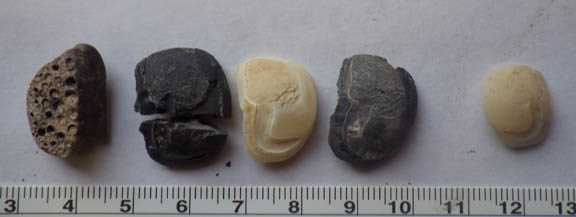Artifacts
Fish Bones – Otoliths, Pharyngeal Arch
 Fish Bones – Otoliths, Pharyngeal Arch These are remains from a fish called the freshwater drum (sheepshead). They were found in a refuse pit at an Oneota site in Onalaska. At the left is a pharyngeal arch—part of two matched pairs of plates in the fish’s throat, used for crushing mussels. The other four are otoliths, or “ear stones.” An otolith in each ear helps the fish with balance and movement. Two of the otoliths are burned. The three otoliths in the center are all lefts, and the one at the right is a right, from smaller fish. These right and left otoliths came from four different fish, and the pharyngeal arch represents another, smaller fish, bringing the total to five. Different sides and sizes of fish bones help us figure out how many fish are represented—the Minimum Number of Individuals, or MNI.
Fish Bones – Otoliths, Pharyngeal Arch These are remains from a fish called the freshwater drum (sheepshead). They were found in a refuse pit at an Oneota site in Onalaska. At the left is a pharyngeal arch—part of two matched pairs of plates in the fish’s throat, used for crushing mussels. The other four are otoliths, or “ear stones.” An otolith in each ear helps the fish with balance and movement. Two of the otoliths are burned. The three otoliths in the center are all lefts, and the one at the right is a right, from smaller fish. These right and left otoliths came from four different fish, and the pharyngeal arch represents another, smaller fish, bringing the total to five. Different sides and sizes of fish bones help us figure out how many fish are represented—the Minimum Number of Individuals, or MNI.
Freshwater drum have the largest otoliths of our freshwater fishes. The shape of drum otoliths makes them easy to identify, and their composition allows for exceptional preservation at archaeological sites. Comparing measurements of archaeological otoliths to modern specimens from fish of known weights provides a way for biologists and archaeologists to estimate size- and the contribution of drum fish to the diet. Otoliths from drum weighing 40 pounds or more have been found at La Crosse area Oneota sites.
In addition to mussels, drum eat snails and a variety of crustaceans.

